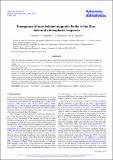Emergence of non-twisted magnetic fields in the Sun : jets and atmospheric response
Abstract
Aims. We study the emergence of a non-twisted flux tube from the solar interior into the solar atmosphere. We investigate whether the length of the buoyant part of the flux tube (i.e. λ) affects the emergence of the field and the dynamics of the evolving magnetic flux system. Methods. We perform three-dimensional (3D), time-dependent, resistive, compressible magnetohydrodynamic (MHD) simulations using the Lare3D code. Results. We find that there are considerable differences in the dynamics of the emergence of a magnetic flux tube when λ is varied. In the solar interior, for larger values of λ, the rising magnetic field emerges faster and expands more due to its lower magnetic tension. As a result, its field strength decreases and its emergence above the photosphere occurs later than in the smaller λ case. However, in both cases, the emerging field at the photosphere becomes unstable in two places, forming two magnetic bipoles that interact dynamically during the evolution of the system. Most of the dynamic phenomena occur at the current layer, which is formed at the interface between the interacting bipoles. We find the formation and ejection of plasmoids, the onset of successive jets from the interface, and the impulsive heating of the plasma in the solar atmosphere. We discuss the triggering mechanism of the jets and the atmospheric response to the emergence of magnetic flux in the two cases.
Citation
Syntelis , P , Archontis , V , Gontikakis , C & Tsinganos , K 2015 , ' Emergence of non-twisted magnetic fields in the Sun : jets and atmospheric response ' , Astronomy & Astrophysics , vol. 584 , A10 , pp. 1-15 . https://doi.org/10.1051/0004-6361/201423781
Publication
Astronomy & Astrophysics
Status
Peer reviewed
ISSN
1432-0746Type
Journal article
Description
The authors acknowledge support by the EU (IEF-272549 grant) and the Royal Society. The present research has been co-financed by the European Union (European Social Fund-ESF) and Greek national funds through the Operational Program “Education and Lifelong Learning” of the National Strategic Reference Framework (NSRF) – Research Funding Program: Thales. Investing in knowledge society through the European Social Fund. This research has also been carried out in the frame of the research program of the RCAAM of the Academy of Athens and has been co-financed by the Program “IKY Scholarships” of the Greek national funds through the Operational Program Education and Lifelong Learning of the NSRF through the European Social Fund of ESPA 2007-2013. Finally, the work reported in this article was additionally supported by the SOLARNET project, funded by the European Commisions FP7 Capacities Program, under the Grant Agreement 312495. The simulations were performed on the STFC and SRIF funded UKMHD cluster, at the University of St Andrews.Collections
Items in the St Andrews Research Repository are protected by copyright, with all rights reserved, unless otherwise indicated.

